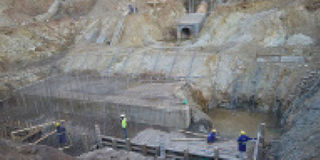Nyagak III power dam works hit a snag over funding gap

Labourers work on a power house at Nyagak III power dam in Zombo District last year. PHOTO/CLEMENT ALUMA
What you need to know:
The contractor needs Shs22 billion to complete the power generation project
The construction of the Nyagak III power dam in Zombo District has hit a snag following the government’s failure to avail funds for its completion.
In July last year, the contractor asked for additional funding of Shs22 billion for the completion of the project, but to date, the money has not yet been provided.
Speaking to the Daily Monitor at the weekend, the State Minister for Energy, Mr Sidronius Okaasai Opolot, said the project is stumbling.
“The contractor needed Shs22 billion in a Supplementary Budget, but it was not provided. I wouldn’t like to talk about this matter, but we were advised to budget for it in the 2023/2024 Financial Year,” Mr Okaasai stated.
He said the delay in funding will affect the generation of more power for West Nile Sub-region.
The director of Hydromax and Dott Services, which is constructing the dam, Mr Mahesh Reddy, said the project has faced funding challenges and they need support from the government.
“Already, we have spent Shs30 billion on this project and we need Shs22 billion to complete the remaining works. We have got those loans from commercial banks at high interest rates, but other funders want to see government commitment first before they can come in,” Mr Reddy said.
The 6.6MW Nyagak III power plant was meant to have been completed in September 2022, but the contractor in July last year asked for more time to finish the work. This power plant is meant to supplement the 3.5MW already being generated from Nyagak I, which has often had breakdown challenges.
The Chief Executive Officer of Uganda Electricity Transmission Company (UETCL), Mr Michael Talemwa, said West Nile would not be connected to the national grid by March 2023 as earlier promised by the Energy minister, Ms Ruth Nankabirwa.
He asked the people of West Nile to wait until the end of March.
The situation now, however, leaves the region in a state of uncertainty about when they will get stable and reliable power to spur industrial development that could attract investment.
The region is currently facing intermittent power supply with most power being used for lighting and small scale users for metal and fabrication.




